
Kottayam is one of 14 districts in the Indian state of Kerala. Kottayam district comprises six municipal towns: Kottayam, Changanassery, Pala, Erattupetta, Ettumanoor, and Vaikom. It is the only district in Kerala that does not border the Arabian Sea or any other Indian state.
Kalady or Kaladi is a town located between Angamaly and Perumbavoor, east of the Periyar river, near to Malayattoor in Ernakulam district of Kerala, India, not far from Cochin International Airport. It is notable as the birthplace of 9th century Indian philosopher Adi Shankara.
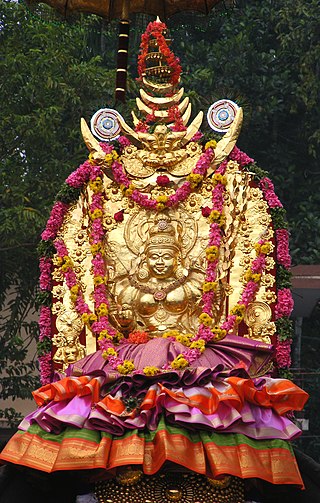
Kumaranalloor is a suburb of Kottayam city, Kottayam taluk, Kerala, India. Kottayam city is just 5 km south of Kumaranalloor. The region was administered by the Kumaranallur grama panchayath till 2010, before the local self-governing body was merged into the Kottayam municipality. The former Panchayath office now exists as the regional administrative office for the municipality. The village is situated on the banks of Meenachil river.

Rama Kulasekhara was the last ruler of the Chera Perumal dynasty of medieval Kerala. He was a contemporary to Chola kings Kulottunga I (1070–1120) and Vikrama Chola. Rama Kulaskehara is best known for briefly recovering Kollam-Trivandrum-Nagercoil region from the powerful Chola empire around 1100/02 AD.

Vazhappally is a suburb of Changanasserry Municipality, Kottayam District, in central Kerala. The famous Vazhappally Shiva Temple is situated in Vazhappally. Vazhappally is a part of Changanacherry Taluk in Kottayam District. It is located in the city of Changanacherry and Vazhappally Panchayath. The ancient Vazhappally gramam (village) was shifted to the Changanassery Municipality, so small portions of the village were reunited in the Municipal Town of Changanassery, while the rest were reconstructed in the Vazhappally Gram Panchayat.

The Kingdom of Thekkumkur was an independent kingdom in the southern part of Kerala in India from 1103 CE until 1750 CE. It was ruled by the Thekkumkur Royal Family. Thekkumkur lies between the Meenachil River and the Pamba River, from the Western Ghats to the Vembanad Kayal. Thekkumkur emerges as a result of administrative changes in the princely states at the end of the Chera Kulasekhara dynasty of Mahodayapuram. The literal meaning of the title is the southern regent and the attribute southern distinguished them from another kingdom known as Vadakkumkur which bordered it in the northern side. The royal household, Thekkumkur Kovilakam, were at Vennimala and Manikandapuram near Puthuppally, later it shifted to Neerazhi Palace at Puzhavathu of Changanassery and Thalilkotta at Thaliyanthanapuram (Kottayam).

Rama Rajasekhara was a Chera Perumal ruler of medieval Kerala, south India. Rajasekhara is usually identified by historians with Cheraman Perumal Nayanar, the venerated Shaiva (Nayanar) poet-musician of the Bhakti tradition.

The Bhoothalingaswamy Temple is an Indian temple located at Boothapandi, India, dedicated to the deity Lord Shiva and notable for its ancient architecture and religious significance. It serves as the headquarters of the Thovalai taluk and is situated 7 km northeast of the village Nagercoil, which is positioned on the western bank of the River Pazhaiyar, at the foot of the hill known as Thadagai Malai, which is widely believed by Hindus to be the abode of Thadakai in the Ramayana, thus adding to its religious importance.

Kaviyoor Mahadevar Temple is one of the important Siva temples in Kerala, located in Kaviyoor, Tiruvalla Pathanamthitta District, Kerala, India. It is commonly called Thrikkaviyoor Mahadeva Temple. The main deity is Lord Mahadeva (Shiva) with Parvathi.The temple is well known for the Hanuman temple situated inside the temple complex. Kaviyoor Temple is one of the important Special Grade temples under the Travancore Devaswom Board.
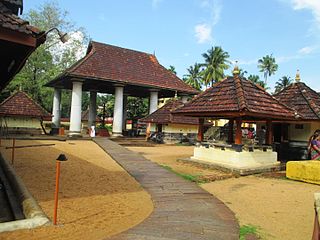
ThiruvanchikulamSivaTemple is a Hindu temple situated in Kodungallur in Thrissur district of Kerala state, India. Constructed in the Kerala style of architecture, the temple is believed to have been built during the Chera period. Shiva is worshipped as Mahadeva and his consort Parvathi as Umadevi. There are 33 sub-deities in this temple, the highest number so in Kerala.
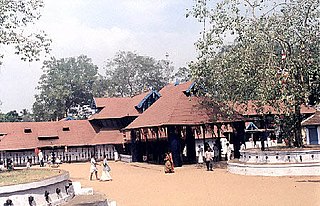
Sree Kurumba Bhagavati Temple is a Hindu temple at Kodungallur, Thrissur District, Kerala state, India. It is dedicated to the goddess Bhadrakali, a form of Mahakali or simply Durga or Aadi Parashakthi worshipped and significantly revered in Kerala. The goddess is known also by the names "Sri Kurumba"". This temple is the head of 64 Bhadrakali temples in Kerala. This Mahakali temple is one of the oldest functioning temples in India. The goddess of the temple represents the goddess in her fierce ('ugra') form, facing North, featuring eight hands with various attributes. One is holding the head of the demon king Daruka, another a sickle-shaped sword, next an anklet, another a bell, among others. Routine worship at the temple every day at 03:00 and ends at 21:00 local time.
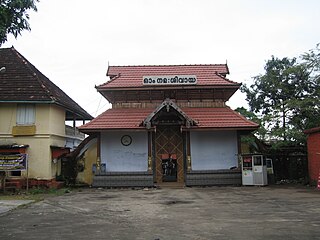
Ernakulam Shiva Temple, also known as Ernakulathappan Temple is one of the major temples of Kerala, located in heart of Ernakulam, Kochi,Kerala, India. The temple, dedicated to Lord Shiva, is considered as the city temple, with the presiding deity as the protector of the city, as per local Hindu faiths and traditions. As per the common practice in Kerala, the deity is reverently called Ernakulathappan, which means Lord of Ernakulam. The temple is located within the Durbar Hall Ground. The temple history itself has deep association with history of the city and was one of the 7 royal temples of Kochi Maharajas. The temple is now under administration of Cochin Devaswam Board. The temple in its current form was built under active patronage of Diwan Sri Edakkunni Sankara Warrier in year 1846 and raised it level of a Royal temple in the Kochi Kingdom. The temple is built on 1-acre (4,000 m2) land. The temple is one of the major Shiva temples in Kerala counted along with the Ettumanoor Mahadevar Temple, Kaduthruthy Mahadeva Temple, Vaikom Temple, Chengannur Mahadeva Temple, Vadakkunathan temple, and Sreekanteswaram Mahadeva Temple, Thiruvananthapuram.

Thirumittakode Anchumoorthi Temple is a Hindu temple equally associated with the deities Vishnu and Shiva. Temple is situated on the banks of the Bharathappuzha at Thirumittacode of Palakkad District in Kerala state in India. The five statues - one for Shiva and four Vishnu - are known here as Thirumattikodu five (Anchu) Moorthy Temple.
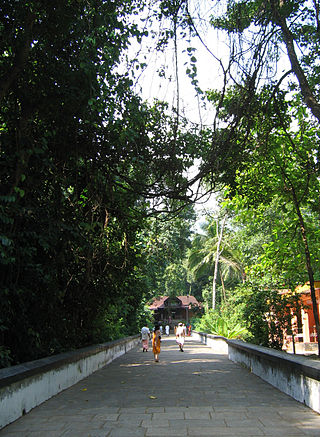
Kottiyoor Temple is a prominent Shiva temple in Kottiyoor, Kannur, Kerala, India. It was under the Kattan dynasty of Puralimala, from which the name 'Katti-yoor' originated. This name later evolved into Kottiyoor in the local dialect. Vadakkeshwaram Temple is the common name of the temple from ancient times, but some of the local people address the temple as Ikkare Kottiyoor as it is on the bank of the river close to the Kottiyoor village, to differentiate it from the shrine in the other side of the river. Thruchherumana Kshetram is also another name by which temple is known. The temple is a special category temple under Malabar Devaswom board.

Pandalam dynasty a royal dynasty emerged from a branch of Pandya kingdom. which existed in Kerala during the Kollam era. They came to Kerala fearing the assault of the Nayaks of Madurai. In Kerala they were given land and status by Kaipuzha Thampan of Nilambur Kovilakam a landlord who lived in Amanthur Palace at Kaipuzha from Kottayam Kerala. Today Pandalam is part of Pathanamthitta, Kerala, India.
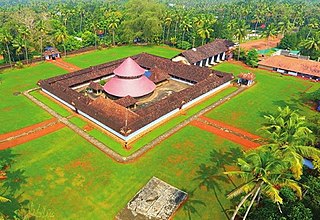
Avittathur Mahadeva Temple, an ancient Hindu temple dedicated to Lord Shiva is situated at Avittathur village of Thrissur District in Kerala state in India. Avittathur gramam (village) is one of the 64 original Brahmin settlements in the ancient Kerala. The Avittathur temple as well as Avittathur Gramam is equally famous like Thaliparamb gramam, Sukapuram gramam, Irinjalakuda gramam and Peruvanam gramam. Avittathur Mahadeva Temple is more than 2000 years old and four old inscriptions have been discovered. According to folklore, sage Agastya has installed the idol of Lord Shiva. It is also believed that the temple's shiva lingam was installed by lord Parasurama the sixth incarnation of Lord Maha Vishnu. The temple is a part of the famous 108 Shiva temples of Kerala.

Vazhappally copper plate is a copper plate inscription in Malayalam language from Vazhappally, in the state of Kerala, south India. Recent scholarship puts the date of the plate in c. 882/83 AD.

Sree Perunthatta Siva Temple is an ancient Hindu temple dedicated to Lord Shiva situated in Guruvayur of Thrissur District in Kerala state in India. According to folklore, sage Parashurama has installed the idol of Lord Shiva in the Treta Yuga. The temple is a part of the 108 famous Shiva temples in Kerala. Therefore, the Saiva-Vaishnava glow is a holy abode.
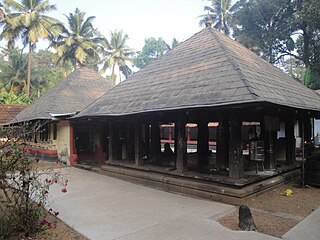
Thiruvatta Mahadeva Temple is an ancient Hindu temple dedicated to Lord Shiva is situated on the banks of the Manimalayar (river) in Thiruvalla of Pathanamthitta District in Kerala state in India. Reference to this temple is found in Vazhappally inscription relates to the rule of Kodungallur Chera king Rama Rajasekhara and temple at Vazhappally. It is the earliest available epigraphical record mentioning a Kodungallur Chera king and written in Malayalam language. According to folklore, sage Parashurama has installed the idol of Lord Shiva in the Treta Yuga. The temple is a part of the 108 famous Shiva temples in Kerala.

Cheraman Perumal dynasty, also known as the Perumal dynasty of Kerala, or Chera Perumals of Makotai, were a ruling dynasty in present-day Kerala, South India. Mahodayapuram, or Makotai, the seat of the Cheraman Perumals, is identified with present-day Kodungallur in central Kerala. Initially, their influence appeared limited to the area between present-day Quilon and Quilandy, but later extended to up to Chandragiri river in north Kerala and to Nagercoil in the south.
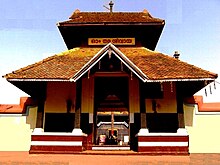


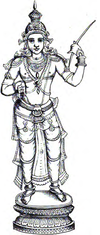




![vaalllpplllliksseetrttile dvaarpaalk[?].jpg](http://upload.wikimedia.org/wikipedia/commons/thumb/a/a9/%E0%B4%B5%E0%B4%BE%E0%B4%B4%E0%B4%AA%E0%B5%8D%E0%B4%AA%E0%B4%B3%E0%B5%8D%E0%B4%B3%E0%B4%BF%E0%B4%95%E0%B5%8D%E0%B4%B7%E0%B5%87%E0%B4%A4%E0%B5%8D%E0%B4%B0%E0%B4%A4%E0%B5%8D%E0%B4%A4%E0%B4%BF%E0%B4%B2%E0%B5%86_%E0%B4%A6%E0%B5%8D%E0%B4%B5%E0%B4%BE%E0%B4%B0%E0%B4%AA%E0%B4%BE%E0%B4%B2%E0%B4%95%E0%B5%BC.jpg/83px-%E0%B4%B5%E0%B4%BE%E0%B4%B4%E0%B4%AA%E0%B5%8D%E0%B4%AA%E0%B4%B3%E0%B5%8D%E0%B4%B3%E0%B4%BF%E0%B4%95%E0%B5%8D%E0%B4%B7%E0%B5%87%E0%B4%A4%E0%B5%8D%E0%B4%B0%E0%B4%A4%E0%B5%8D%E0%B4%A4%E0%B4%BF%E0%B4%B2%E0%B5%86_%E0%B4%A6%E0%B5%8D%E0%B4%B5%E0%B4%BE%E0%B4%B0%E0%B4%AA%E0%B4%BE%E0%B4%B2%E0%B4%95%E0%B5%BC.jpg)



























